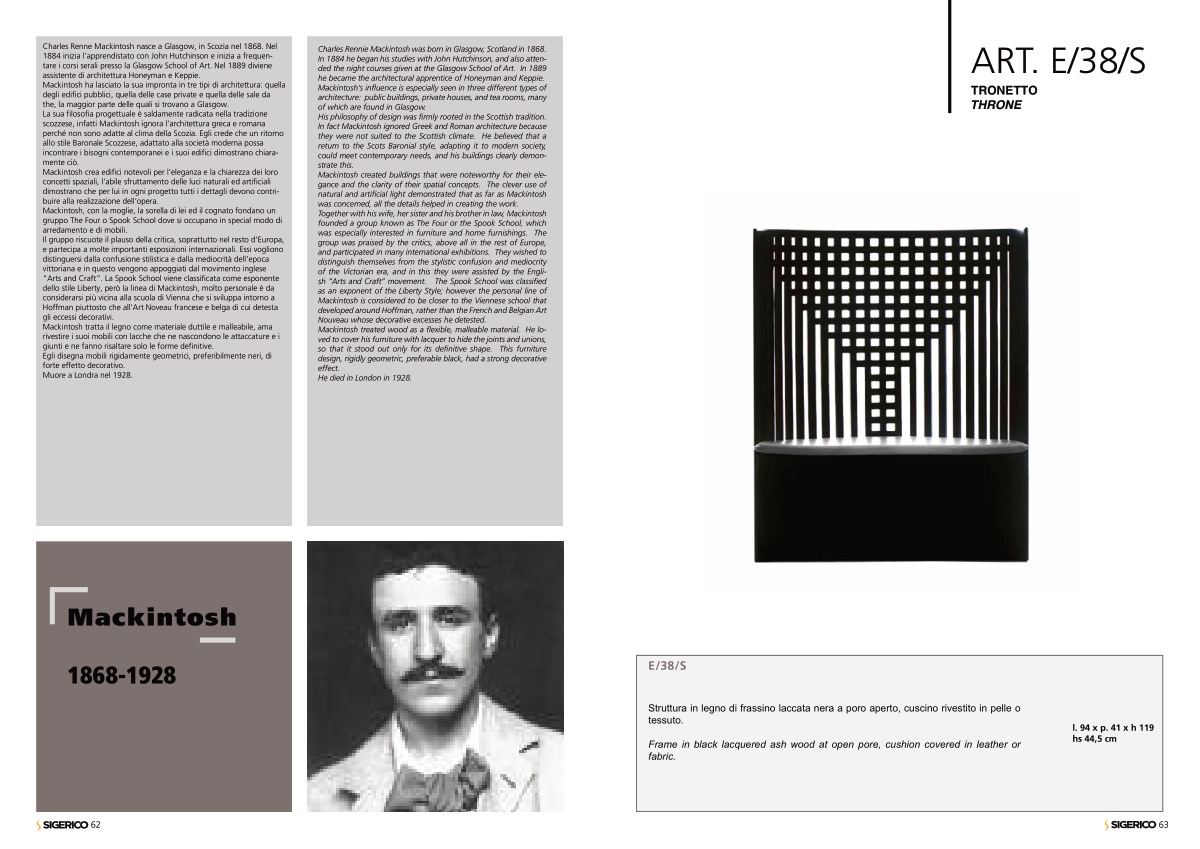Mackintosh
1868-1928
Charles Renne Mackintosh nasce a Glasgow, in Scozia nel 1868. Nel
1884 inizia l’apprendistato con John Hutchinson e inizia a frequen-
tare i corsi serali presso la Glasgow School of Art. Nel 1889 diviene
assistente di architettura Honeyman e Keppie.
Mackintosh ha lasciato la sua impronta in tre tipi di architettura: quella
degli edifici pubblici, quella delle case private e quella delle sale da
the, la maggior parte delle quali si trovano a Glasgow.
La sua filosofia progettuale è saldamente radicata nella tradizione
scozzese, infatti Mackintosh ignora l’architettura greca e romana
perché non sono adatte al clima della Scozia. Egli crede che un ritorno
allo stile Baronale Scozzese, adattato alla società moderna possa
incontrare i bisogni contemporanei e i suoi edifici dimostrano chiara-
mente ciò.
Mackintosh crea edifici notevoli per l’eleganza e la chiarezza dei loro
concetti spaziali, l’abile sfruttamento delle luci naturali ed artificiali
dimostrano che per lui in ogni progetto tutti i dettagli devono contri-
buire alla realizzazione dell’opera.
Mackintosh, con la moglie, la sorella di lei ed il cognato fondano un
gruppo The Four o Spook School dove si occupano in special modo di
arredamento e di mobili.
Il gruppo riscuote il plauso della critica, soprattutto nel resto d’Europa,
e partecipa a molte importanti esposizioni internazionali. Essi vogliono
distinguersi dalla confusione stilistica e dalla mediocrità dell’epoca
vittoriana e in questo vengono appoggiati dal movimento inglese
“Arts and Craft”. La Spook School viene classificata come esponente
dello stile Liberty, però la linea di Mackintosh, molto personale è da
considerarsi più vicina alla scuola di Vienna che si sviluppa intorno a
Hoffman piuttosto che all’Art Noveau francese e belga di cui detesta
gli eccessi decorativi.
Mackintosh tratta il legno come materiale duttile e malleabile, ama
rivestire i suoi mobili con lacche che ne nascondono le attaccature e i
giunti e ne fanno risaltare solo le forme definitive.
Egli disegna mobili rigidamente geometrici, preferibilmente neri, di
forte effetto decorativo.
Muore a Londra nel 1928.
Charles Rennie Mackintosh was born in Glasgow, Scotland in 1868.
In 1884 he began his studies with John Hutchinson, and also atten-
ded the night courses given at the Glasgow School of Art. In 1889
he became the architectural apprentice of Honeyman and Keppie.
Mackintosh’s influence is especially seen in three different types of
architecture: public buildings, private houses, and tea rooms, many
of which are found in Glasgow.
His philosophy of design was firmly rooted in the Scottish tradition.
In fact Mackintosh ignored Greek and Roman architecture because
they were not suited to the Scottish climate. He believed that a
return to the Scots Baronial style, adapting it to modern society,
could meet contemporary needs, and his buildings clearly demon-
strate this.
Mackintosh created buildings that were noteworthy for their ele-
gance and the clarity of their spatial concepts. The clever use of
natural and artificial light demonstrated that as far as Mackintosh
was concerned, all the details helped in creating the work.
Together with his wife, her sister and his brother in law, Mackintosh
founded a group known as The Four or the Spook School, which
was especially interested in furniture and home furnishings. The
group was praised by the critics, above all in the rest of Europe,
and participated in many international exhibitions. They wished to
distinguish themselves from the stylistic confusion and mediocrity
of the Victorian era, and in this they were assisted by the Engli-
sh “Arts and Craft” movement. The Spook School was classified
as an exponent of the Liberty Style; however the personal line of
Mackintosh is considered to be closer to the Viennese school that
developed around Hoffman, rather than the French and Belgian Art
Nouveau whose decorative excesses he detested.
Mackintosh treated wood as a flexible, malleable material. He lo-
ved to cover his furniture with lacquer to hide the joints and unions,
so that it stood out only for its definitive shape. This furniture
design, rigidly geometric, preferable black, had a strong decorative
effect.
He died in London in 1928.
ART. E/38/S
TRONETTO
THRONE
Struttura in legno di frassino laccata nera a poro aperto, cuscino rivestito in pelle o
tessuto.
Frame in black lacquered ash wood at open pore, cushion covered in leather or
fabric.
l. 94 x p. 41 x h 119
hs 44,5 cm
63
62
E/38/S


